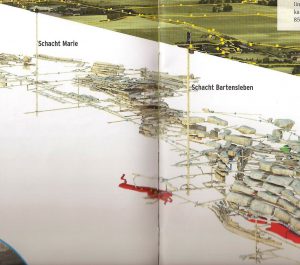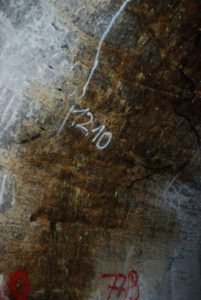[:ja]前回は中間貯蔵について話をし,核燃料の放射能減衰のグラフを見て,中間貯蔵の想定している 30 年から50年という短期間では不足であることを見てきました.数万年以上の貯蔵,それが最終処分です.どのようなことが考えられているのでしょうか?
最終処分の方法
地層処分
最終処分の方法として現在現実的なものは地層処分です.驚きですが,以前は核廃棄物を海に捨てる,海洋投棄があったようです.しかし,環境を汚染する海洋投棄は今では国際的に禁止されています.現在では核廃棄物を地中深く掘って埋める地層処分が最も現実的な方法と考えられています.
地層処分では放射線を以下の2つの方法で遮蔽します.
- 人工バリア: 容器,コンクリート
- 自然バリア: 地層
このうち,遮蔽効果のほとんどは地中深く埋める自然バリアによってもたらされます.
廃棄物のレベルと国によってどれだけ深く埋めるかには次のような分類があり,異なっています.
- 低中レベル放射性廃棄物
- 浅層 (数百メートルの深度(日本等))
- 中層
- 深層 (1000m 前後 (ドイツ等))
- 高レベル放射性廃棄物(+TRU廃棄物)
- 深層処理
高レベル放射性廃棄物の地層としては次のような候補があり,それぞれ特徴があります.
- 粘土層:
- 欠点: 熱伝導率が低く,熱が逃げないので,地層が高レベル放射性廃棄物の熱で乾燥して亀裂が入り,汚染が漏れる危険がある.
- 花崗岩層:
- 欠点: 岩盤が硬いので掘るのに莫大なコストがかかる上,地層に地下水がある可能性があり,地下水によって汚染が拡散される.
- 岩塩層:
- 利点: 熱伝導率が高く,熱を逃がしやすいので.高レベル放射性廃棄物の熱が拡散される.
- 欠点: 過去海だったため,どこかに水がある可能性が高く,水によって汚染が拡散される危険がある.
最終処分の地層としては廃棄物を長期間安定に保存するために,以下の条件が求められます.
- 地層が均一である (均一であれば亀裂などがない,または起こりにくい)
- 地下水が流れこまない (地下水によって汚染が拡散してしまう可能性がある)
- 地層の移動がない (移動があると廃棄物が安定して保存されない)
地下水が流れているとか,亀裂があるなどとなると,長期間の保存では保存している核廃棄物が環境を汚染する可能性があります.そのため水(地下水)の有無は重要な条件になります.
最終処分場の事例
地層処分とは,地上から2本の竪坑を掘って,地下に坑道を作って最終処分に適した地層に放射性廃棄物を保管できるようにすることです.
図 4 は,東ドイツ時代にモアスレーベン(Morsleben)で建設,使用されていた低中レベル放射性廃棄物の最終処分場です.地下に壮大な貯蔵場が必要なことがわかります.なお,モアスレーベンの最終処分場は岩塩層が落盤する危険があることから,使用を中断し,閉鎖されることが決定されました.
図 4.写真: 独モアスレーベンの最終処分場構造図 (写真提供: ふくもと氏)
ドイツのゴアレーベン(Gorlben)は当初,放射性廃棄物の総合処理場にする計画がありました.まず,中央中間貯蔵施設が設置されました.そのうちに,そこに最終処分場を設置する目的でその地下岩塩層が高レベル放射性廃棄物に適するかどうかの調査施設が建設されました.ただ,その適性には疑問もあり,これまで調査を中断したり,再開するなどを繰り返してきました.現在は最終処分場の候補地を白紙に戻して,最終処分地を選定するための委員会が国会内に設置されています.
図 5.写真: 地層内にある油 (独ゴアレーベン) (写真提供: ふくもと氏)
図 5 は,ゴアレーベン地下調査坑道内の地層の写真です.黒い部分は油のある層で,岩塩層が均一でないことがわかります.
次回
ここまでで最終処分の方法についてみてきました.実際の最終処分場はまだ世界にはほとんどありません.しかし核のゴミは既に存在し,増え続けています.我々の世代はこの負担をしなくてはいけません.でなければ危険なものが処理されずに存在することになります.実際にはどこかにほおっておくという手もありますが,負担そのものはなくなりません.やまうち個人としてはこのほおっておく,放置する,という形の負担はしたくありません.なぜなら,そちらの方が結局もっと高くつくためです.どうせ負担しなくてはいけないのなら安くして欲しいのです.放置しておくという解答は,それで死人が出たり病人が出たり,国土が汚染され利用できなくなるという形での負担になるからです.この負担はどのようになっているのでしょうか? 次回は最終処分の資金についてのお話です.[:en]
Deep geological repository
One method for the final disposal storage is the deep geological repository method. Surprisingly, there was also an ocean disposal method. However, this method has environmental problems and is no longer permitted by international agreements. The deep geological repository method basically digs a deep hole and stores the waste in the hole. This method is considered as the most practical method.
The deep geological repository method blocks the radiation by two
methods.
- Artificial barrier: container, concrete wall
- Natural geological barrier: stratum
Most of the radiation blocking effect is by the natural barrier.
The level of the waste and the criterion of how deep the waste should be stored depends on the country. Some examples are following:
Low-, Middle-level waste
- shallow (a few hundreds meters (e.g., Japan))
- middle
- deep (around 1000m (e.g., Germany))
High-level waste (+TRU waste)
- deep geological storage
The stratum suited for high level nuclear waste are following. Each has own characteristics.
- Clay stratum
Disadvantage: This stratum has low thermal conductivity and the
heat would not be well diffused. Therefore, the stratum could be
dried out and might generate cracks. The waste would possibly
leak through such cracks. - Granite stratum
Disadvantage: The rock is relatively hard, thus the cost of
digging is quite high. There could be ground water and the water
diffuses the contamination of the waste. - Rock salt stratum
Advantage: This stratum has high thermal conductivity and the
heat of the high level waste is well diffused.\\
Disadvantage: It is highly possible to have ground water since it
was a sea in the past. The water diffuses the contamination of
the waste.
For long term geological waste management, the following conditions are necessary for the stratum to stably store the waste.
- Uniformity. (If the stratum is uniform, there is less possibility
to have cracks, or less possible to cause them.) - No ground water. (Ground water possibly diffuses the waste.)
- No movement. (We cannot stably store the waste in moving strata.)
Ground water and cracks may distribute the radioactive contamination, especially for the long term waste storage. Therefore, the non existence of ground water is an important condition.
Example of long term deep geological repository
The deep geological repository method typically consists in digging two vertical holes and connecting them with a tunnel under the ground where the stratum is suited for long term waste management. The waste will be stored in the tunnel.
Figure 4 shows the long term storage facility for low-/middle-level waste in Morsleben in the Eastern Germany time. You can see the huge storage faciliy under the ground. Later the government decided to stop using it and closed the Morsleben’s storage facility since there is a danger of rockfall for the rocksalt stratum.

Gorlben (in Germany) had a plan to build a general waste processing facility. First, the central interim storage facility has been built. Then, a facility was built to check that whether the rocksalt stratum of this area is suitable for the long term storage. However, there were some questions regarding the suitability, the investigation was suspended and reopened, repeatedly. The government decided to start over the process of choosing a location. A committee that will choose the candidate location has been established at the parliament.
Picture: oil in the stratum (Gorleben, Germany)

Figure 5 shows a pictures of stratum in the tunnel of Gorleben. The black part is oil and that means the rocksalt stratum is not uniform.[:]
